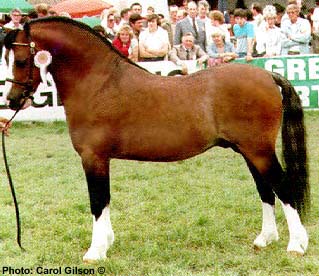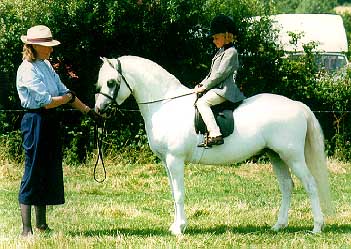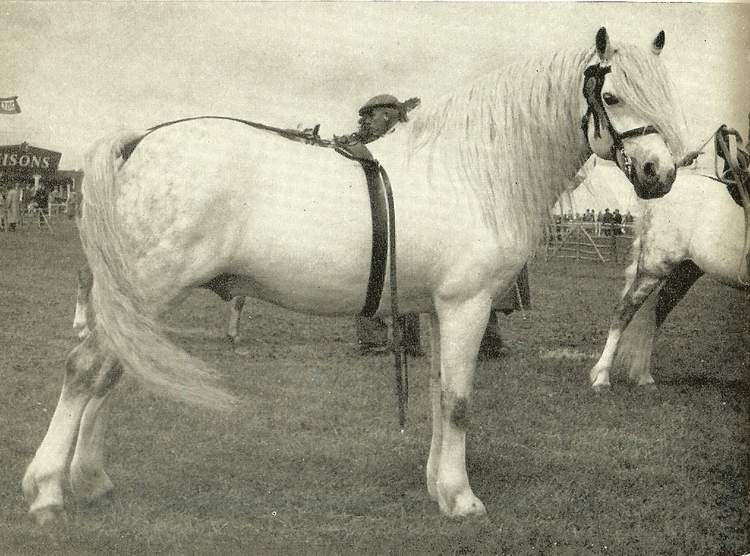

Welsh Mountain
Pony
(Section A)


Introduction: This is the original and smallest of all the Welsh breeds, of which there are four total "sections." If you have any comments or suggestions, please click here.
Names: Welsh Mountain, Welsh Mountain Pony (Section A in the Welsh Pony and Cob Society studbook, opened in 1902). Sometimes mistakenly called the Welsh Pony, especially in the United States.
Origin:
Britain's oldest recorded native
breed, its origins are thought to date back to the wild ponies of Wales in
ancient Celtic times. It evolved in the hills of Wales
before the Romans inhabited that area and was probably upgraded by Arab-type
animals brought to Britain by the Romans. They have been given added
quality by more recent infusions of Arabian
blood. In 1974, about 20,000 were registered in the United
States; I believe with the Welsh Pony Society of America.
Great Britain. Welsh mountains. Breeds in the
open, runs in herds with approved pedigree stallions. Also bred in many
lowland studs throughout Great Britain and the rest of the world. The
Welsh Mountain Pony was already in Wales at the time of the Roman occupation.
Probably descended from the Celtic pony.
Breeding: Originally a wild native type, the Mountain pony was considerably refined by the introduction of Eastern blood some hundred years ago, when a number of Arabian stallions were turned out among Welsh mares. A feral or semi-wild pony indigenous to the mountains and moorlands of Wales.
Description: Today's Welsh is markedly Arabian in many points of conformation, especially the head, neck, and high-set tail. I couldn't resist including this beautiful picture of the stallion Coed Coch Madog.

Action: Moves with a flexible, elevated forward reach. Regular, even movement in walk and trot. Showy. Nimble and very surefooted, can jump.
Body: Back strong, short, and well-coupled. Croup slightly sloping. Deep girth. Loins broad and muscular. Neck arched and well set on. Sloped shoulders. Good neck, well-made long shoulders. Strong back with strong loins. Good quarters.
Color: Should be of a solid color. In the U.S. they are usually gray, white, or chestnut. Usually gray or chestnut; can be any color except piebald or skewbald. Very often grey, also chestnut, black or bay roan, but also other colours, except piebald and skewbald.
Hair: Strong, well-developed mane and tail. Tail is set and carried high and well.
Head: Arab-type; small with prominent cheeks and pretty dished face. Ears tiny, delicate, and pricked. Eyes large, dark, and wide-set. Profile either straight or slightly dished. Expressive, decidedly Arab head with small, pointed ears.
Hooves: Hard and round. Good and strong.
Legs: Short and strong, with short cannon bones. Well-placed, strong forelegs.
Size: The smallest of the Welsh ponies. Up to, not exceeding, 12 hands. One source says the official limit is 12.2 hands. Must not exceed 12 hands. 52-56 inches.
Temperament: Gentle and very sensible.
Features: Safe
for children. Sure-footed and strong as well as elegant. Sometimes
prove too high-couraged and quick in their reactions for novices to ride alone.
Easily maintained. Fine harness enthusiasts
admire the Welsh's smart action, but the Welsh Pony Society of America prefers
to emphasize the horse's excellent riding qualities. In the hunting field,
especially, his spirit and relish for jumping are exceptional.
Small mountain pony. Hardy, enduring, long-living,
indigenous. Its equable temperament, surefootedness and
"toughness" make it an ideal children's and harness pony.
Uses: Popular show pony for riding and driving. They make wonderful leading-rein ponies, are very successful in the show ring and go well in harness. An admirable riding pony, it is an ideal mount for small children. Formerly much used in coal mining, but with the mechanization of that industry it has been converted mainly into a riding pony for children and teenagers.
Accomplishments:
Curiosities:
Profiles:
Conclusion: